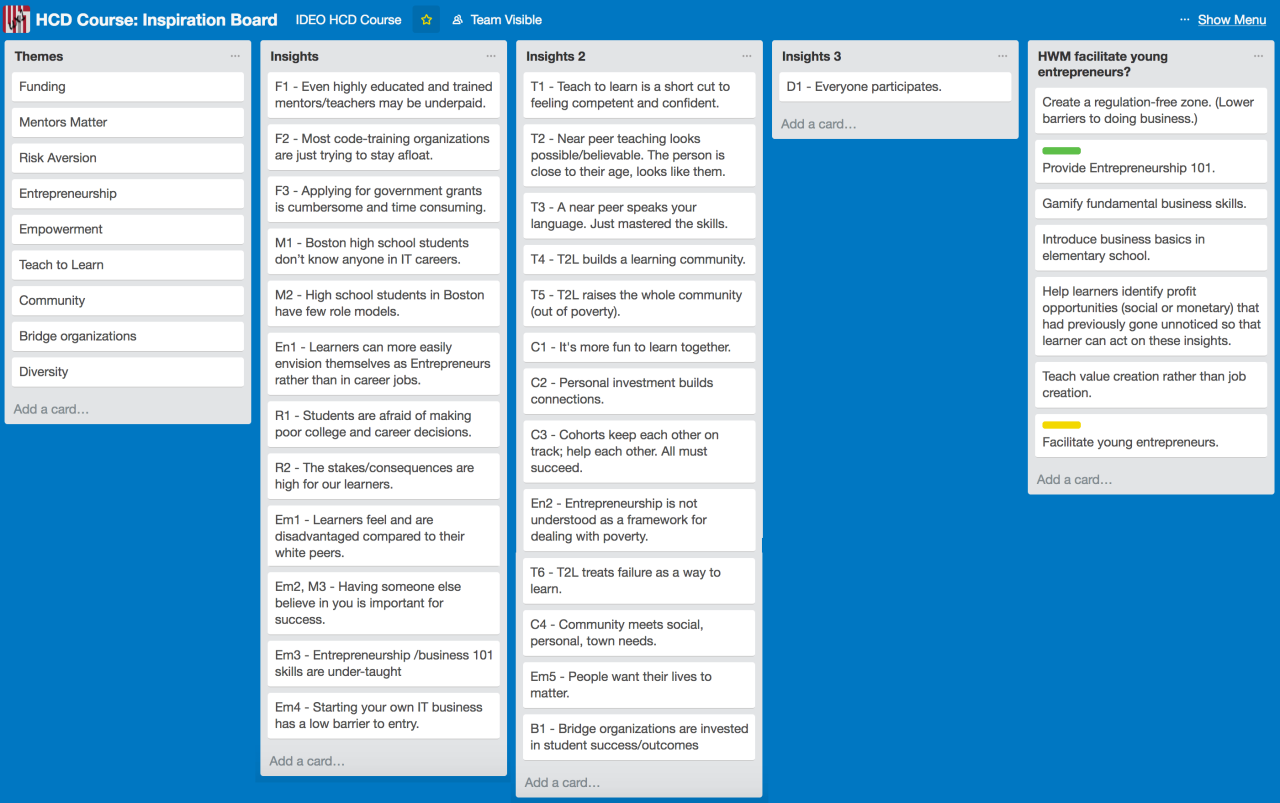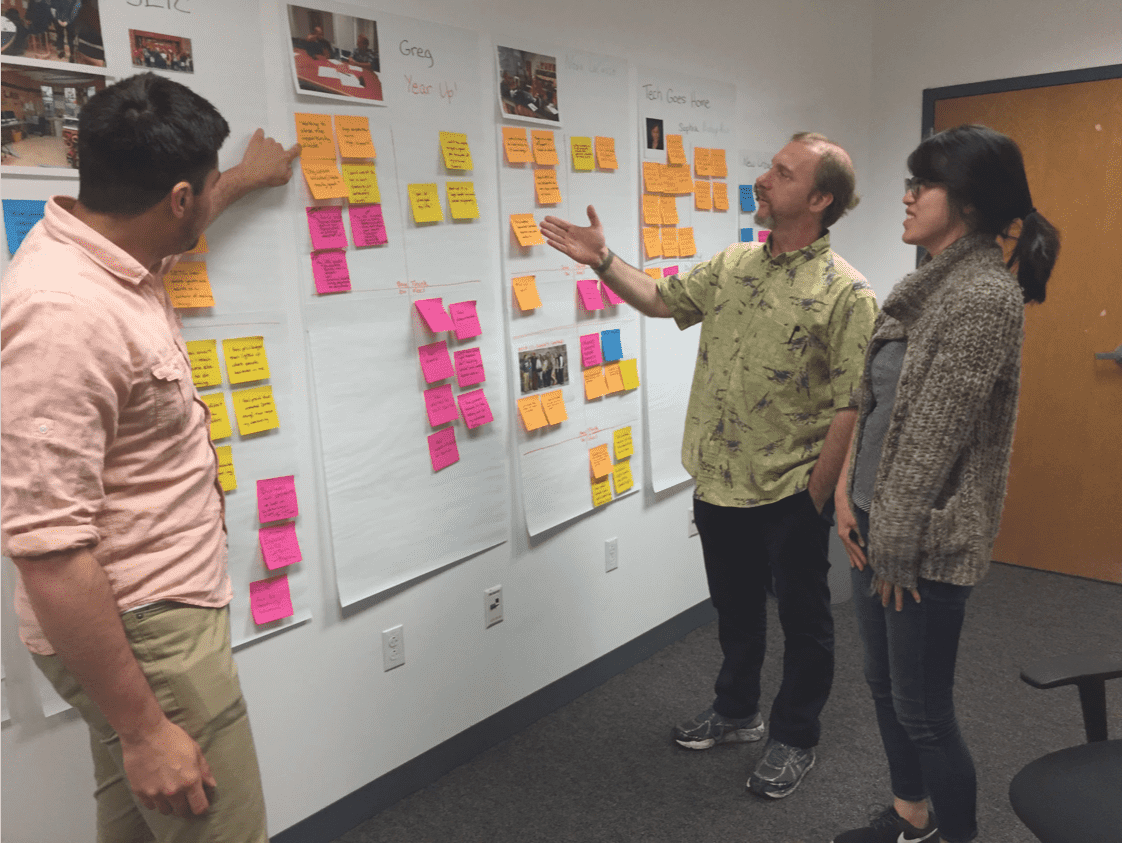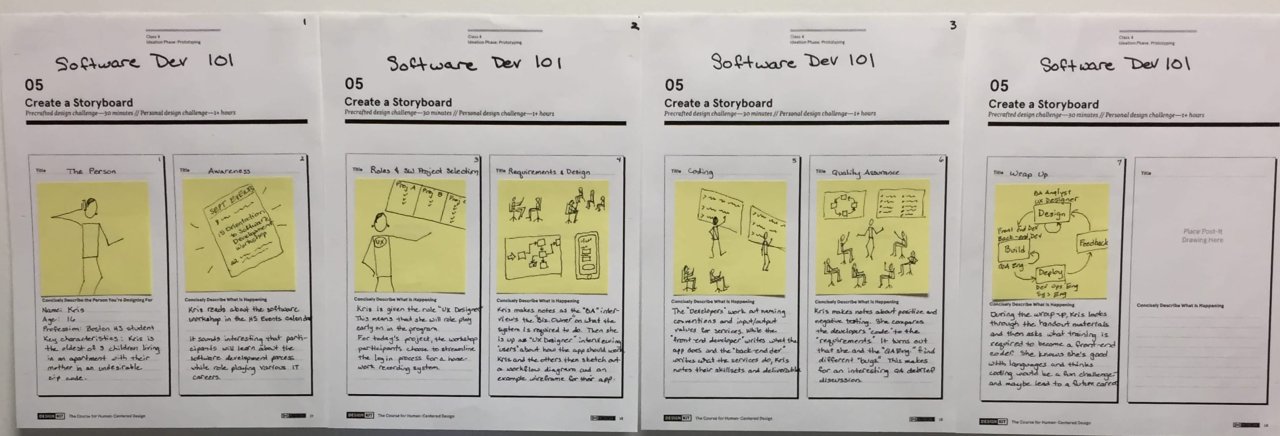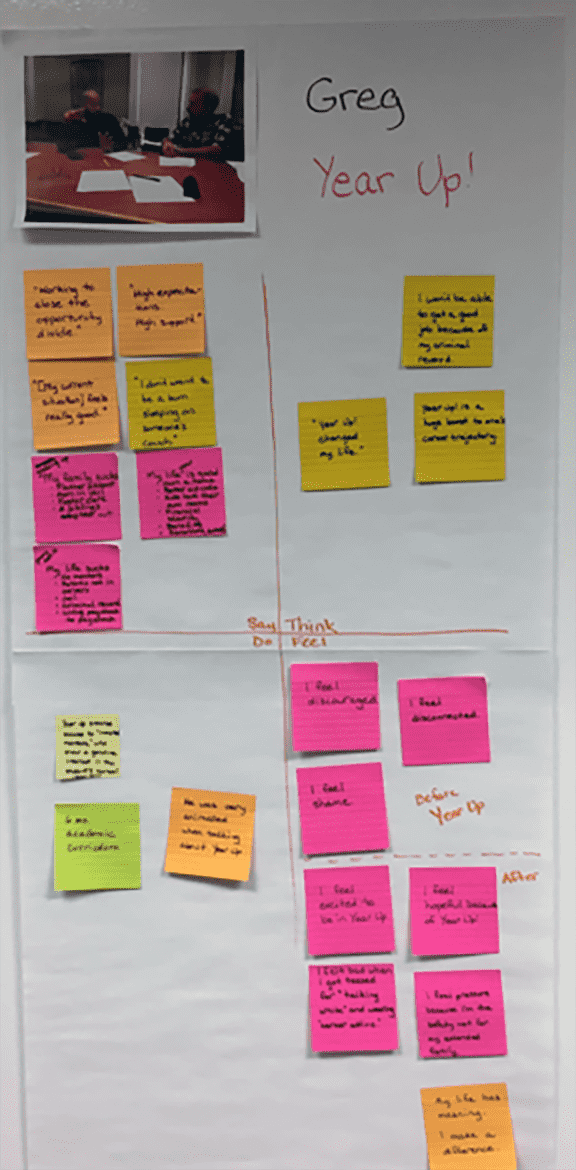Human Centered Design: Bridging the IT Divide
A Case Study in Human Centered Design caption: Focusing on real people to try to solve challenging problems we face in our own communities
-
On Behalf Of
- MIT
- IST
- Boston Public Schools
- Resilient Coders
-
Service Provided
Problem Solving Research -
Year Active
March 16th, 2016 — March 16th, 2017 -
Deliverables
- Curriculum
- User Research
- Workshops
TLDR:
When I was with the MIT UX team, we used Human Centered Design to gain a deeper understanding of the needs and challenges of underserved young adults in Boston. We learned how we ourselves, and our careers at MIT, could become role models for youth who do not have a window into the Tech world and its well-paying jobs. In designing and running this workshop were able to test it by inviting students into a role-playing environment.
Each individual student is assigned a product team role, to then partner with with business owners, end users, and other stakeholders to help solve real problems and be guided in creating a great product. We as the curriculum creators shared our knowledge and expertise, in partnership with Commonwealth Corporation, to have this workshop be run with at least 2,800~ Boston high school students a year, beginning in early 2018. (Based on the 2015 graduation rate from 4-year Boston public high schools).
A Case Study in Human Centered Design
When I was with the MIT UX team, we used Human-Centered Design to gain a deeper understanding of the needs and challenges of underserved young adults in Boston. We learned how we and our careers at MIT could become role models for youth who do not have a window into the Tech World and its well-paying jobs. In designing and running this workshop were able to test it by inviting students into a role-playing environment.
Each student is assigned a product team role to then partner with business owners, end-users, and other stakeholders to help solve real problems and be guided in creating a great product. We, as the curriculum creators, shared our knowledge and expertise, in partnership with Commonwealth Corporation, to have this workshop be run with at least 2,800~ Boston high school students a year, beginning in early 2018. (Based on the 2015 graduation rate from 4-year Boston public high schools).
Focusing on real people to try to solve challenging problems we face in our own communities
+Acumen created the Introduction to Human-Centered Design course in collaboration with IDEO.org, the nonprofit design organization that designs products, services, and experiences to improve the lives of people in poor and vulnerable communities. In addition to actually making things to improve the lives of people living in poverty, they are working to get the social sector at large to take a human-centered approach to problem solving too.
Human-centered design is a creative approach to problem solving that starts with building empathy for the end users, generates a lot of ideas, and ends with innovative solutions tailored to the end users needs. This approach can be used for any number of challenges, such as products, services, spaces or systems. For instance, “How might we design a course to introduce students to the IT career roles involved in the software development lifecycle?”
In partnership with the Mayor's Office and Boston Public Schools, the Boston Private Industry Council (PIC) Career Specialists connect thousands of High School students to internships and summer jobs with local employers. During the school year they arrange career awareness and job readiness activities. For curriculum development, PIC collaborates with Commonwealth Corporation, a skills building organization. Commonwealth Corp became the local entity with whom we partnered for this project.
UX Team’s Involvement
In spring 2017 a team of 4 MIT staff members, Bertha Kuo, Nancy Gift, and myself from the UX team, aswell as Mike Berger from the Data Science team, embarked on the free, online "Introduction to Human Centered Design" course. We were interested in learning about and trying out IDEO's design philosophy as professional development. This was our initial experience applying HCD.
Our challenge: How might we engage more youth in STEM careers?
Process
Breaking up the work into phases.
The inspiration phase includes brainstorming what you know/don't know and assumptions about the selected challenge topic, planning who to visit/interview, creating interview protocols, conducting the research and then documenting what you've seen, heard, felt, touched or smelled.

Design Challenge
We discussed and wrote out a small brief to get us on the same page.
Our first draft: "Helping poor and minority youth and young adults successfully fill good IT jobs in Boston."
Which led to this problem to solve: While some disadvantaged Boston area youth and young adults are interested in coding as a way to raise their standard of living, many fail to achieve their goal. We want to understand what is stopping them from getting good paying IT jobs. What are the barriers they face and can Design Thinking remove, overcome or sneak around these barriers?
As we continued to ask design questions: "How Might We (HMW) build a bridge of knowledge and empowerment for disadvantaged Bostonian's over barriers to IT jobs?"
Hoping that we could reach this impact goal: "Reduce poverty; increase education; increase self-esteem; improve quality of life."
Plan and Conduct Field Research
We began by listing what we needed to learn and who might have that information. We created a Trello board to track individuals we wanted to interview and another Trello board to capture possible interview questions.
We were privileged to meet with:
We talked with some experts:
The Mayor's Office New Urban Mechanics (Nigel Jacob, Kim Lucas, Sabrina Dorsainvil)
A high school coding teacher at Boston Community Leadership Academy (Nova LaCasse)
Also talking to and including people that were already solving the problems:
An alum and advocate for Year Up! (Greg Walton)
We found some organizations with goals aligned with ours:
South End Technology Center (SETC) (Mel King, Dr. Susan Klimczak)
CodeSquare (Andrew Ott)
Boston Private Industry Council (Alysia Ordway)
Tech Apprentice (Alysia Ordway)
Commonwealth Corporation (Susan Lange, Jennifer Applebaum)
Tech Goes Home (Sophia Rice)
We talked to some local recruiters at companies like:
Yelp
MIT (Tony Williams)
Google
We also spoke to a few students.
Interviewed with 9 BCLA 11th Graders in Miss LaCasse's coding class

Ideation Phase: Synthesis
Learnings
To shared our learnings with the rest of the team, each interview session had its own board and photo(s) where we collected stories, quotes and observations, written on stickie notes, sorted into 4 quadrants: Say, Think, Do, Feel.
Themes, Insights, HMW
During brainstorming sessions we organized these stories, observations and quotes into meaningful clusters and labeled each cluster with a "theme." For each theme, we then wrote insight sentences to capture, new, rediscovered and relevant points of view. We then wrote the insights in the form of "How Might We" questions. Below is our cleaned up Trello Inspiration board.
A sample from our learnings:
Theme: Funding
Insights:
Even highly educated and trained mentors/teachers may be underpaid.
Most code-training organizations are just trying to stay afloat.
HMW: How might we (as a society) better reward STEM trainers, teachers?
Project Ideas
Our next brainstorming session was to generate project ideas that would satisfy our HMW questions. From that exercise we selected 1-2 ideas that energized the team and reworded them to this new format:
It would be game changing if ______________________.
Using this process we arrived at an idea that both excited our team and fit our time and resource levels:
Theme: Role Models
Insight: Disadvantaged Boston high school students do not have IT role models.
Insight: Boston high schools rely on volunteers to come in person to talk about their IT careers.
HMW engage more youth in STEM careers?
HMW we support youth making decisions about choosing a career path?
Concept: It would be game changing to provide an IT Career hands-on workshop, encompassing software development careers, that could be adapted for Boston High School use. To accomplish this we partnered with the Commonwealth Corporation's Jennifer Applebaum.
We also did an evaluation exercise to determine if everyone on the team had the same understanding of the project idea.

Exercise to get team alignment on project.
Our proposed solution
During our initial interview with Susan Lange and Jennifer Applebaum, from Commonwealth Corporation, they became very excited about our IT Career Workshop concept. They were eager to partner with us so that they could re-purpose our workshop idea into a segmented curriculum appropriate for high school class schedules. Starting with the first draft of the curriculum he had created and presented in 2016 for Resilient Coders, an organization “spreading code literacy to young people from traditionally underserved communities,” Mike Berger revised the script based on feedback from its first presentation.
Following that effort, storyboards were created, the revised script was tested with high school-aged teens, and we started designing and iterating various charts and diagrams to enhance the workshop. The text also went through another round of revisions to incorporate the high school feedback.
Our Prototype and Test
We presented the workshop on Sept. 27, 2017 at Resilient Coders. Commonwealth Corp representatives attended and observed the 2 hour session. Fifteen students participated, split into 2 groups. Mike and Ben each facilitated a team while Nancy acted as observer and photographer.
The workshop was a very collaborative exercise and before long the students were fully engaged and self-leading their teams.
After the Sept. 27 workshop we handed off our files to Jennifer Applebaum. She and her colleague, Janell, enjoyed the workshop and came away with pages of notes and a fresh perspective on how the content and engagement could be translated to the high school classroom. At this time we await survey feedback from the workshop participants and our collaborators. We will also schedule a feedback session so that we can learn Commonwealth Corporation's point of view working in the Boston public high school system.

